5G is emerging as the technology to address critical wireless communication requirements in public safety, infrastructure, and industry with the following categories of connectivity services:
- Enhanced Mobile Broadband (eMBB)
- Ultra Reliable Low Latency Communications (URLLC)
- Massive Machine Type Communications (mMTC)
In addition, 5G also presents other significant technical differentiators relative to all other wireless technologies, including 4G. Those differentiators enable a broad set of enterprise applications, business motivations, and operational models that other wireless technologies cannot fill.
5G Technical Differentiators
- eMBB Features
The following 5G Enhanced Mobile Broadband (eMBB) features contributes to reaching connectivity speeds of hundreds of megabits per second per application, a rate previously only available through fiber.- Massive MIMO allows more antennas to support multiple data streams and beamforming.
- Extensive bandwidth support means more radio resources could be utilized to improve throughput (up to 400 MHz).
- High-order modulation could increase spectral efficiency. For 5G, both downlink and uplink data channels support 256QAM modulation.
Benefits: This is fast enough to support ultra-highdefinition (UHD) video feeds running at hundreds of megabits per second each, making remote visual inspection viable.

- URLLC Low-Latency Features
With 5G, the targeted Ultra-Reliable Low-Latency Communication (URLLC) one-way user plane latency is 1 millisecond. The low latency is made possible via a new physical layer design and core network features, including the following: - Flexible numerology: New numerologies with flexible subcarrier spacing and bandwidth leading to the shorter slot.
- Non-slot based scheduling
- Grant-free UL transmission: Release 16 has uplink grant-free transmissions to reduce latency to enable the UE to transmit immediately when needed without waiting for an explicit indication from the network.
- Pre-emption for downlink: URLLC services can reduce latency by pre-empting uplink eMBB transmissions.
- Short transmissions called mini-slots: Mini-slot (1-13 OFDM symbols) based operation can further reduce latency.
- PDCCH monitoring: Increasing the Physical Downlink Control CHannel (PDCCH) monitoring capability reduces latency.
- Fast hybrid automatic repeat request (HARQ): Supports the use of more than one physical uplink control channel (PUCCH) for hybrid automatic repeat request acknowledgment (HARQ-ACK) transmission within a slot.
- Multi-access Edge Computing (MEC): 5G Core network functions can be implemented as an MEC node local to the device, thus, with low latency access to the application data.
- UPF Selection & Reselection: The 5G core network can (re)select the User-Plane Function (UPF) located close to or at the access network site to route the user traffic to the local data network.
Benefits: This enables a new set of business-critical use cases, such as automated guided vehicles, Augmented Reality/Virtual Reality (AR/VR), factory automation, cloud robotics, and real-time remote control of machines.

- URLLC High-Reliability Features
Reliability is the success probability of transmitting a small packet within a specific latency. With 5G, the targeted URLLC reliability requirement for data is 99.9999% for 32 bytes with a user plane latency of 1 millisecond. This is achieved via a combination of the following 5G features:- Low Rate MCS
- Enhanced hybrid ARQ or blind repetitions that send multiple copies of a given packet rather than waiting for the network to request retransmission when a packet is lost or arrives with errors
- Slot aggregation for the physical uplink shared channel (PUSCH) and the physical downlink shared channel (PDSCH) enables an uplink or downlink transmission to span multiple slots to facilitate improved coverage
- Frequency diversity sends the same information at different frequencies
- Spatial diversity sends the same information using different antennas
- Dual Connectivity: UE initiates two redundant PDU sessions over two gNB and two UPFs
- Redundant user plane paths on multiple UEs per device: The device can implement two UEs, and the traffic is sent toward the two UEs simultaneously
Benefits: 5G enables a new set of life-critical use cases, such as V2X, railway, public safety, and remote surgery applications.

- mMTC Features
Whereas 4G networks can support a maximum of 100,000 devices per square kilometer; 5G Massive Machine-Type Communications (mMTC) can connect up to a million per square kilometer.
Benefits: This addresses the growing industrial need for greater connection density.
For example, BASF’s main production facility in Ludwigshafen, Germany, currently has 600,000 networked sensors and other devices—but it would like to have ten times more.

Spectrum
- Wide Support of Frequency Ranges
One fundamental difference between 5G and the previous cellular technologies is the spectrum.
5G is designed for use in far more frequency bands than 4G, 3G, and 2G, including ones at higher frequencies than cellular has ever used.
Benefits: This provides flexibility in selecting the optimal frequency range to serve the enterprise use cases in a given market.
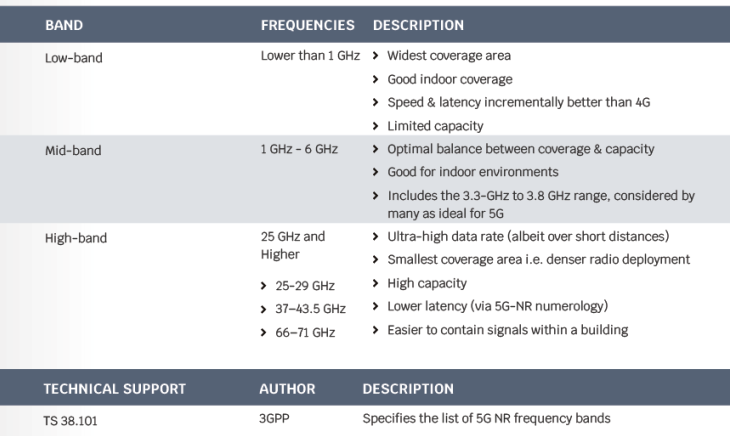
- Support all spectrum licensing schemes
- Private mobile networks based on 5G can be deployed in licensed, shared, or unlicensed spectrum.
- Licensed spectrum (exclusive license): Most regulators have continued to make spectrum available for 5G by auctioning nationwide, exclusive 5G licenses. Alternatively, some countries allocate parts of the 5G spectrum for local use directly to industries.
- Shared spectrum (non-exclusive license): Shared spectrum solutions enable more than one organization to use the same spectrum range in a single geographic area. For example, in the US, the Citizens Broadband Radio Service (CBRS) is a spectrum-sharing framework in the 3.5 GHz range.
- Unlicensed spectrum: Unlicensed spectrum solutions enable the design of a 5G network using a freely available spectrum for public use. An excellent example is the 2.4 GHz and 5 GHz spectrum bands already widely used for Wi-Fi.
Benefits: 5G supports the licensing scheme of the optimal frequency range in any given market, which ultimately expands the viable ecosystem of spectrum providers for a given enterprise.

Network Slicing
Network Slicing is a key architectural feature in 5G that enables multiple virtual networks to be created on a single physical network infrastructure. Network slicing allows the mobile network operator to provide customized networks. A network slice is effectively a logical network serving a defined business purpose or customer consisting of all required network resources configured together.
With network slicing, the 5G system is capable of simultaneously supporting multiple combinations of reliability, latency, throughput, positioning, and availability requirements.
Furthermore, with 5G, mobile operators can offer enterprises some level of control over the set-up and management of their slices via open APIs: Network Slices As-A-Service (NsaaS).
Benefits: With network slicing, the 5G system can simultaneously support multiple combinations of reliability, latency, throughput, positioning, and availability requirements. Network slicing enables operators to provide dedicated virtual networks with customerspecific functionality.


Private Network Models
The term “private networks” has been around for a while but has evolved. Non-Public Network (NPN) is the term adopted by 3GPP for such networks. 3GPP has specified support for two NPN deployment options:
The first, known as Public-Network-Integrated NPNs (PNINPNs), allows Mobile Network Operators (MNOs) to support NPNs by associating them directly with their networks.
Two primary levels of integration to the public network are possible:
- Public Network with Slicing: In this scenario, the NPN is hosted by the public network, and all NPN traffic is routed via the public network.
- Public Network with Dedicated UPF: The radio network and the control plane functions are shared between the private and the public networks. The User Plane Function (UPF) is entirely within the NPN (on a dedicated UPF), supporting NPN data flow within the logical NPN perimeter.
In both scenarios, NPN devices are subscribers to the public network. Both scenarios would significantly benefit from 5G network slicing features for its implementation.
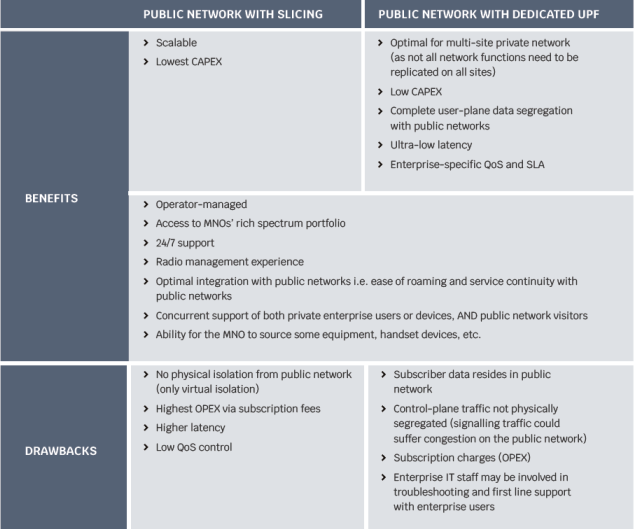
The second deployment option is known as Standalone NPN (S-NPN). An S-NPN has the same functionality and characteristics as a regular public network but is operated by an NPN operator and is not relying on network functions provided by a public network.
The two primary flavors are:
- S-NPN with MNO Spectrum: In this scenario, the NPN only shares the public network’s radio access network (RAN). All other control and user plane functions and network resources remain isolated. NPN data stays within the logical NPN perimeter.
- S-NPN with non-MNO Spectrum: In this scenario, the NPN is logically and physically separate from the public network and is typically operated by the private operator on a shared spectrum, such as citizens’ broadband radio service (CBRS) or an unlicensed spectrum.
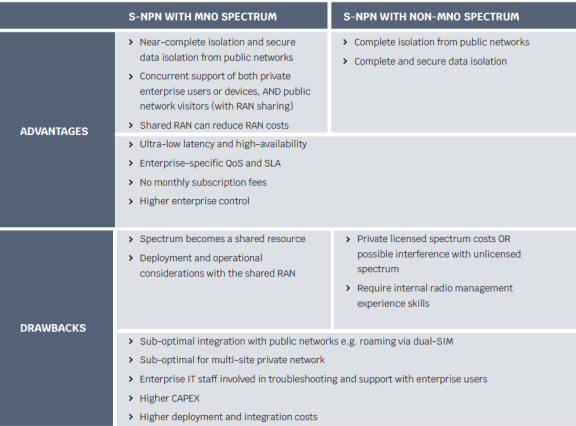

Accurate Positioning
5G Release 16 introduces various DL-based and UL-based positioning methods to meet the accuracy requirements for different use cases. These include support for low-cost devices not equipped with GPS, devices with GPS turned off, and poor satellite coverage.
Several RAT-dependent NR positioning schemes are being considered for private network deployment as follows:
- Downlink Time Difference Of Arrival (DL-TDOA)
- Uplink Time Difference Of Arrival (UL-TDOA)
- Downlink Angle-of-Departure (DL-AOD)
- Uplink Angle-Of-Arrival (UL-AOA)
- Multi-cell Round Trip Time (RTT)
The figure below shows the Expected Positioning Performance of 5G NR relative to other technologies.
Benefits: Support of use-cases such as low-cost devices not equipped with GPS, devices with GPS turned off, and poor satellite coverage. Single and multi-cell positioning brings precision geolocation in support of Intelligent Transport System (ITS) / Vehicle-to-everything (V2X) communications and Industrial Internet of Things (IIoT) applications.
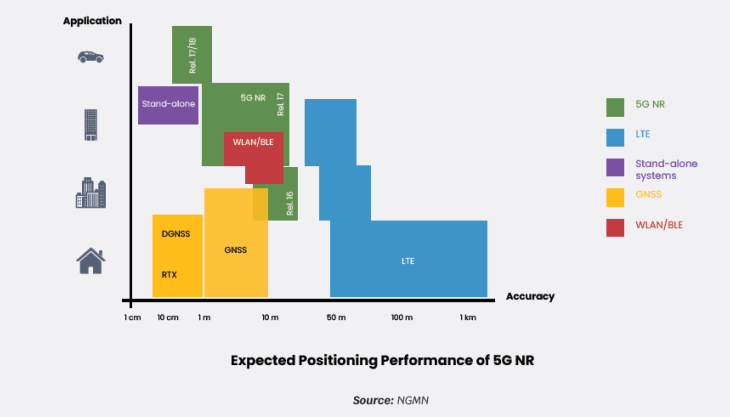

5GLAN
Several technology enablers defined by 3GPP are accelerating the integration of 5G support with industrial LAN. These are:
- Ethernet connectivity support: 5G supports the “Ethernet” type Packet Data Unit (PDU) session. With this, a UE can communicate directly via the 5G network with Ethernet frames.
- Support for Time-Sensitive Network (TSN) integration: 3GPP considers the entire 5G system a TSN-enabled bridge. Thus, time-sensitive traffic can pass through the 5G system while integrated into the TSN-enabled Ethernet-based industrial networks.
- Virtual Network groups: Virtual Network groups are critical to designing a virtual LAN: A 5G Virtual Network (VN) group consists of a set of UEs using private communication for 5G LAN-type services.
Benefits: TSN is important to many industries – for example, aerospace, automotive, transportation, utilities, and manufacturing – and TSN is likely to become the baseline networking technology for real-time industrial networking. Translating wired TSN capabilities into 5G (and vice versa) enables Industry 4.0 applications.
More generally, the 5GLAN feature allows the integration of mobile networks as part of an existing IT infrastructure. 5GLAN reduces the need for Ethernet cabling and exhibits similar connectivity properties.

Sidelink Device-to-device
From 3GPP Release 16, 5G will support vehicle-to-vehicle (V2V) communication for connected cars through the 5G NR sidelink (as opposed to the traditional downlink and uplink communications).
Benefits: Sidelink is being designed to deliver broad benefits for the overall 5G system. Sidelink can effectively enable:
- Transportation safety: Allowing devices and infrastructures to connect and communicate amongst themselves
- Public safety communication: Enabling device-todevice communication when multiple public safety agencies need to communicate with each other with and without the cellular infrastructure
- Range extension: Extending coverage via device-todevice communication (e.g., massive IoT devices, such as meters) with multi-hop mesh relays
- Expanded capacity: Expanding industrial IoT system capacity with direct communications between automation controllers and sensors/actuators

Network Programmability and Exposure
3GPP has introduced several enhancements for the 5G System (5GS), ensuring a seamless integration on the north-bound interface towards industrial applications that use the 5G system.
Common API Framework (CAPIF): Offers a unified framework to expose APIs from 5GS to industrial applications securely.
Service enabler architecture layer (SEAL): Ensures efficient use and deployment of vertical applications over 3GPP systems via SEAL services which include group management, configuration management, location management, identity management, key management, and network resource management.
Network Exposure Function (NEF): NEF is another 3GPP function that allows API invokers (industrial or Network Management applications) to access 5G function capabilities via standardized APIs. The figure below shows the Network Exposure Function information categories.
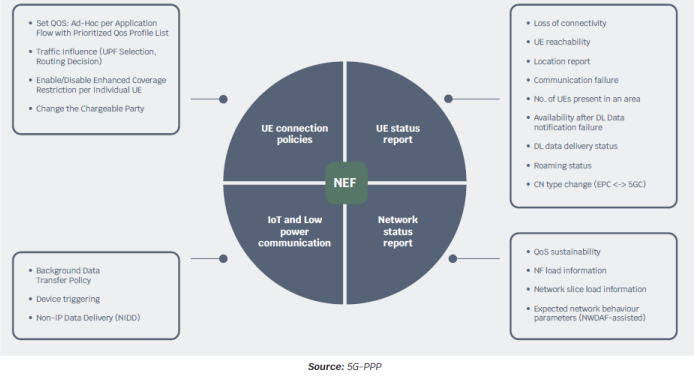

Benefits: With SEAL and NEF, the 5G network exposure capabilities enrich the collaboration between network operators and an ecosystem of third-party enterprise service and application providers.
Cloud-Native
5G introduces a software-defined architecture with stateless network functions and a service-based network framework. The entire networking stack is built in a cloudnative design.
Benefits: Scalability and better utilization of network resources, reduced power consumption and improved space usage efficiency, and reduced operational and capital expenditures. In the context of a 5G private network, the virtualization of the 5G network facilitates its integration into the enterprise IT cloud infrastructure.

MEC
In the context of 5G, Mobile Edge Computing (MEC) is a concept that enables services to be hosted close to the service consumers, with 5G network elements and application servers potentially installed on customer premises.
Benefits: MEC significantly reduces end-to-end latency and load on the transport network, which is crucial to addressing several new and enhanced use cases – including Industrial IoT, Industry 4.0, and autonomous driving.


AI/ML
Artificial Intelligence (AI)/Machine Learning (ML) is a crucial enabler for 5G in automating network planning, network operations, and service assurance.
Benefits: 5G Private Networks can be used as a connectivity platform for closed-loop AI/ML processes. Some use cases in this area include the following:
- Supply chain: Autonomous Vehicles, AI inward goods Inspection
- Assembly: Augmented Reality (AR) guided assembly, Remote Engineering
- Testing: AI Quality Control Inspection, Autonomous functional testing, AR-guided inspection
Coverage and Mobility
With broad support of spectrum and licensing models, as well as support for private network models, 5G provides for:
- Optimal indoor and outdoor coverage: on-premises and off-premises.
- Temporary and ad-hoc coverage: special events, emergencies.
- Global connectivity: 5G devices can roam seamlessly between a private network with local coverage and public networks with global coverage.
- Service continuity: 5G supports service continuity for a UE between private and public networks. When a UE moves out of the radio coverage of the NPN, it may wish to continue its ongoing services received from the NPN. This capability is essential many vertical services like ambulances, transport, and logistics need service continuity while moving from a private network to a public network.
- High-speed mobility: support UE speed of up to 500 km/hour.
- Support for Non-Terrestrial Networks (NTN): improve the value of 5G networks by addressing coverage challenges and complex use cases that ground-based infrastructure alone cannot address.

Security
5G networks include further security improvements over G LTE networks as follows:


Conclusion
This article has presented an overview of the technical differentiators of 5G over other wireless technologies, along with their benefits and technical references. More detailed information can be requested at luc.samson@briskwave.com.









